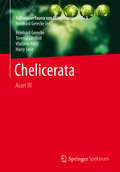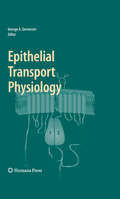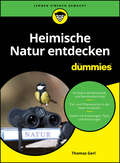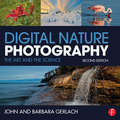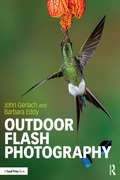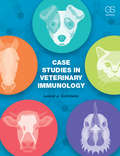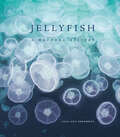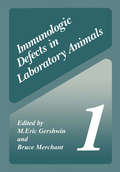- Table View
- List View
Süßwasserfauna von Mitteleuropa, Bd. 7/2-3 Chelicerata: Acari III (Süßwasserfauna von Mitteleuropa)
by Reinhard Gerecke Terence Gledhill Vladimir Pešić Harry SmitFor the first time in limnofaunistic bibliography, the present taxonomic knowledge about the different clades of chelicerata having adapted to an aquatic or amphibious lifestyle along various evolutionary pathways is brought together in an overview for the Central-European fauna. A total number of 746 taxa is covered, over 99 % of these at species level.In Volume 7/2-1 altogether 211 species are treated - 70 species of spiders, 7 species of Astigmata (3 of which to be identified only at family, genus, resp. species group level), 17 species of Oribatida, 27 species and one subspecies of Halacaridae, 45 species of terrestrial Parasitengona (4 of which to be identified only at genus level) and 45 species of Hydrachnidia (4 Stygothrombioidea, 3 Hydrovolzioidea, 16 Hydrachnoidea and 22 Eylaoidea). Volume 7/2-2 deals with 179 species of Hydrachnidia (58 Hydryphantoidea and 121 Lebertioidea).This third volume (Volume 7/2-3) includes taxonomic keys and ecological information for 355 species of the two highly diverse Hydrachnidia superfamilies Hygrobatoidea (241 species and one subspecies) and Arrenuroidea (113 species).The chelicerata volumes of this series are a basic tool for all limnologists interested in diversity and ecology – in particular for biologists investigating the ecotones between ground and surface water, between bottom substrata and open water, and between water and land.
Epithelial Transport Physiology
by George A. GerencserBiological cell membranes regulate the transfer of matter and information between the intracellular and extracellular compartments as basic survival and maintenance functions for an organism. This volume contains a series of reviews that are c- cerned with how epithelial plasma membranes regulate the transport of solutes between the intracellular and extracellular compartments of a cell. This book is also an attempt to analyze the molecular basis for the movement of various solutes across an epithelial cell membrane. This volume is devoted to a diversity of epithelial transport mechanisms in rep- sentative cell membranes of a variety of living things. The ?rst section of the book (Chapters 1–6) focuses on mechanisms of solute transport in epithelia of inver- brates. The last section which comprises ten chapters (Chapters 7–16) deals with solute transporters in epithelial cell membranes of vertebrates. It is hoped that with this particular ordering the reader can glean a telescopic view of the evolutionary history of the various epithelial solute transporters.
Current Antipsychotics (Handbook of Experimental Pharmacology #212)
by Gerhard Gross and Mark A. GeyerSix decades after the serendipitous discovery of chlorpromazine as an antipsychotic and four decades after the launch of clozapine, the first atypical or second generation antipsychotic, psychopharmacology has arrived at an important crossroad. It is clear that pharmacological research and pharmaceutical development must now focus on complementary or even alternative mechanisms of action to address unmet medical needs, i.e. poorly treated domains of schizophrenia, improved acceptance by patients, better adherence to medication, safety in psychoses in demented patients, and avoiding cardiac and metabolic adverse effects. The first completely novel mechanisms evolving from our insights into the pathophysiology of psychotic disorders, especially the role of glutamatergic mechanisms in schizophrenia, are now under development, and further principles are on the horizon. This situation, in many respects similar to that when the initial second-generation antipsychotics became available, can be rewarding for all. Preclinical and clinical researchers now have the opportunity to confirm their hypotheses and the pharmaceutical industry may be able to develop really novel classes of therapeutics. When we were approached by the publishers of the Handbook of Experimental Pharmacology to prepare a new volume on antipsychotics, our intention was to capture both, the accumulated preclinical and clinical knowledge about current antipsychotics as well as prospects for new and potentially more specific antischizophrenia principles. These efforts should be based on the pathophysiology of the diseases and the affected neurotransmitter systems. Since preclinical research on antipsychotic compounds is only reliable when intimately linked through translational aspects to clinical results, we decided to include clinical science as well. It turned out that that this endeavor could not be covered by a single volume. We thank the editorial board and the publishers for supporting our decision to prepare two volumes: Current Antipsychotics and Novel Antischizophrenia Treatments. These topics cannot really be separated from one another and should be seen as a composite entity despite the somewhat arbitrary separation of contributions into two volumes. The continuing challenges of developing improved and safer antipsychotic medications remain of concern and are discussed in the first volume. The new opportunities for the field to develop and license adjunctive treatments for the negative symptoms and cognitive deficits that are treated inadequately by existing compounds have been incentivized recently and provide the focus for the second volume. We hope these collective contributions will facilitate the development of improved treatments for the full range of symptomatology seen in the group of schizophrenias and other major psychotic disorders.Gerhard Gross, Ludwigshafen, GermanyMark A. Geyer, La Jolla, CAThis volume will try to put current therapy - achievements, shortcomings, remaining medical needs - and emerging new targets into the context of increasing knowledge regarding the genetic and neurodevelopmental contributions to the pathophysiology of schizophrenia. Some of the chapters will also deal with respective experimental and clinical methodology, biomarkers, and translational aspects of drug development. Non-schizophrenia indications will be covered to some extent, but not exhaustively.
Atlas des Mittel- und Zwischenhirns des Kaninches: Atlas of the mes- and diencephalon of the rabbit
by Lieselotte GerhardAtlas des Mittel- und Zwischenhirns des Kaninches: Atlas of the mes- and diencephalon of the rabbit
by Lieselotte GerhardThe Ecology of Animal Senses: Matched Filters for Economical Sensing
by Gerhard von der Emde Eric WarrantThe collection of chapters in this book present the concept of matched filters: response characteristics “matching” the characteristics of crucially important sensory inputs, which allows detection of vital sensory stimuli while sensory inputs not necessary for the survival of the animal tend to be filtered out, or sacrificed. The individual contributions discuss that the evolution of sensing systems resulted from the necessity to achieve the most efficient sensing of vital information at the lowest possible energetic cost. Matched filters are found in all senses including vision, hearing, olfaction, mechanoreception, electroreception and infrared sensing and different cases will be referred to in detail.
Verzeichnis der Käfer Schlesiens: preußischen und österreichischen Anteils
by Julius GerhardtDieser Buchtitel ist Teil des Digitalisierungsprojekts Springer Book Archives mit Publikationen, die seit den Anfängen des Verlags von 1842 erschienen sind. Der Verlag stellt mit diesem Archiv Quellen für die historische wie auch die disziplingeschichtliche Forschung zur Verfügung, die jeweils im historischen Kontext betrachtet werden müssen. Dieser Titel erschien in der Zeit vor 1945 und wird daher in seiner zeittypischen politisch-ideologischen Ausrichtung vom Verlag nicht beworben.
Verzeichnis der Käfer Schlesiens preußischen und österreichischen Anteils, geordnet nach dem Catalogus coleopterorum Europae vom Jahre 1906
by Julius GerhardtDieser Buchtitel ist Teil des Digitalisierungsprojekts Springer Book Archives mit Publikationen, die seit den Anfängen des Verlags von 1842 erschienen sind. Der Verlag stellt mit diesem Archiv Quellen für die historische wie auch die disziplingeschichtliche Forschung zur Verfügung, die jeweils im historischen Kontext betrachtet werden müssen. Dieser Titel erschien in der Zeit vor 1945 und wird daher in seiner zeittypischen politisch-ideologischen Ausrichtung vom Verlag nicht beworben.
Heimische Natur entdecken für Dummies (Für Dummies)
by Thomas GerlEntdecken Sie Wunder der Natur direkt vor der eigenen Haustür Entdecken Sie, was die Natur zu bieten hat. Dazu müssen Sie nicht weit reisen, sondern beginnen direkt vor Ihrer Haustür. Thomas Gerl erklärt Ihnen, was es über die größten heimischen Naturräume zu wissen gibt. Sie lernen die jeweiligen Besonderheiten und die interessantesten Bewohner kennen. So bekommen Sie ein eindrückliches Bild von den Lebewesen Ihrer Region, angereichert mit biologischen Hintergrundinformationen und vielen praktischen Tipps für erfolgreiche Naturbeobachtungen. An konkreten Beispielen erfahren Sie außerdem, wie sich der Rückgang der biologischen Vielfalt auswirkt und wie Sie dabei helfen, ihn zu stoppen. Sie erfahren Wie sich die Vielfalt des Lebendigen ordnen lässt Was Sie bei Erkundungstouren in der Natur beachten sollten Wo und wie Sie bestimmte Tiere und Pflanzen finden Wie Naturbeobachtung dazu beiträgt, Lebewesen zu erhalten
Close Up Photography in Nature
by John and GerlachCapturing the grandeur of landscapes or mood of a certain natural light is challenging but often the simple details of a texture or color evade photographers most of all. In Close Up Photography in Nature, best-selling authors and nature photography pros, John and Barbara Gerlach, share the tips and techniques necessary to successfully photograph the beauty all around you. The Gerlachs are celebrated teachers who understand a photographer's mind so they begin this book with a brief overview of the fundamentals before delving into some of the more advanced and unique challenges of close up photography. Topics covered include: advanced flash techniques specific for close up shooting, as well as a discussion on focus stacking strategies and tilt-shift lenses for getting maximum depth-of-field. The Gerlachs also discuss their strategy of mixing flash with natural light when shooting close up, which opens up all sorts of photographic possibilities – opening up shadows, creating shadows, separating the subject from the background, reducing contrast between the subject and the background, improving the color rendition, shooting sharper images, and much more. This book will change the way you see the world as well as the way you share it through your work! the world through your work!
Close Up Photography in Nature
by John and GerlachCapturing the grandeur of landscapes or mood of a certain natural light is challenging but often the simple details of a texture or color evade photographers most of all. In Close Up Photography in Nature, best-selling authors and nature photography pros, John and Barbara Gerlach, share the tips and techniques necessary to successfully photograph the beauty all around you. The Gerlachs are celebrated teachers who understand a photographer's mind so they begin this book with a brief overview of the fundamentals before delving into some of the more advanced and unique challenges of close up photography. Topics covered include: advanced flash techniques specific for close up shooting, as well as a discussion on focus stacking strategies and tilt-shift lenses for getting maximum depth-of-field. The Gerlachs also discuss their strategy of mixing flash with natural light when shooting close up, which opens up all sorts of photographic possibilities – opening up shadows, creating shadows, separating the subject from the background, reducing contrast between the subject and the background, improving the color rendition, shooting sharper images, and much more. This book will change the way you see the world as well as the way you share it through your work! the world through your work!
Digital Nature Photography: The Art and the Science
by John and GerlachIdentifying a beautiful image in nature is easy, but capturing it is often challenging. To truly seize the essence of a photograph shot out of the studio and in the world requires an artistic eye and impeccable set of photographic techniques. John and Barbara Gerlach have been teaching photographers how to master the craft of photographing nature and the outdoors through their workshops and best-selling books for more than twenty years. Now, equipped with brand new images to share and skills to teach, this celebrated photo team is sharing their latest lessons in the second edition of Digital Nature Photography. Notable revisions in this new edition include introducing the concepts of focus stacking and HDR, as well as expanded discussions of multiple exposure, wireless flash, RGB histograms, live view, shutter priority with auto ISO, hand-held shooting techniques, and the author’s equipment selections. The inspiring imagery in this book covers a broader range of subjects than before including ghost towns, the night sky, animals, and sports, in addition to the classic nature photographs we expect from this very talented author team. This book is a comprehensive guide to one of the broadest subjects in photography, explained and dymystified by two respected masters.
Digital Nature Photography: The Art and the Science
by John and GerlachIdentifying a beautiful image in nature is easy, but capturing it is often challenging. To truly seize the essence of a photograph shot out of the studio and in the world requires an artistic eye and impeccable set of photographic techniques. John and Barbara Gerlach have been teaching photographers how to master the craft of photographing nature and the outdoors through their workshops and best-selling books for more than twenty years. Now, equipped with brand new images to share and skills to teach, this celebrated photo team is sharing their latest lessons in the second edition of Digital Nature Photography. Notable revisions in this new edition include introducing the concepts of focus stacking and HDR, as well as expanded discussions of multiple exposure, wireless flash, RGB histograms, live view, shutter priority with auto ISO, hand-held shooting techniques, and the author’s equipment selections. The inspiring imagery in this book covers a broader range of subjects than before including ghost towns, the night sky, animals, and sports, in addition to the classic nature photographs we expect from this very talented author team. This book is a comprehensive guide to one of the broadest subjects in photography, explained and dymystified by two respected masters.
Outdoor Flash Photography
by John Gerlach Barbara EddyMaximizing the power of your camera’s flash is difficult enough in a studio set-up, but outdoors literally presents a whole new world of challenges. John Gerlach and Barbara Eddy have taken the most asked about subject from their renowned photography workshops and turned it into this guidebook that is sure to inspire your next outdoor shoot, while also saving you time and frustration. Outdoor Flash Photography covers a range of practices from portrait to landscape, including unique strategies that the authors have pioneered through 40 years in the field. Mastering the use of multiple flashes to freeze action is shown through one of most challenging subjects in nature, hummingbirds in flight. This book will benefit photographers of all experience levels who are eager to evolve their outdoor photography and get the most out of their equipment.
Outdoor Flash Photography
by John Gerlach Barbara EddyMaximizing the power of your camera’s flash is difficult enough in a studio set-up, but outdoors literally presents a whole new world of challenges. John Gerlach and Barbara Eddy have taken the most asked about subject from their renowned photography workshops and turned it into this guidebook that is sure to inspire your next outdoor shoot, while also saving you time and frustration. Outdoor Flash Photography covers a range of practices from portrait to landscape, including unique strategies that the authors have pioneered through 40 years in the field. Mastering the use of multiple flashes to freeze action is shown through one of most challenging subjects in nature, hummingbirds in flight. This book will benefit photographers of all experience levels who are eager to evolve their outdoor photography and get the most out of their equipment.
Die Parkinson-Krankheit: Grundlagen, Klinik, Therapie
by Manfred Gerlach Heinz Reichmann Peter RiedererKompetent: Das einzige Lehrbuch im deutschsprachigen Raum zur Parkinson-Krankheit. Umfassend beschreibt es neurobiologische Grundlagen, Modelle, Klinik und Therapie. Kompakt: Pharmakologie und Wirkmechanismen der Anti-Parkinson-Medikamente. Komprimiert: viele Tabellen, Schemata und Abbildungen. Das Nachschlagewerk besticht durch klare Systematik und Aktualität. Neu in der 4. Auflage des Leitfadens: alle neuen Medikamente, neueste Entwicklungen in der Genetik, Pathogenese- und Therapieforschung. Plus: aktuelle Modelle der Parkinson-Krankheit und der gegenwärtige Stand klinischer Studien zur symptomatischen Therapie und Neuroprotektion.
The Principles of Riding: Basic Training for Horse and Rider
by German National Equestrian FederationThe first edition of The Principles of Riding was published more than 50 years ago, imparting mandatory basic knowledge for all areas of equestrian sport and horse-keeping and this 28th edition, Basic Training for Horse and Rider, has been completely revised regarding language and content, while still taking into account the well-established principles. The consideration of traditional principles leads to the education and training of the horse according to its nature and thus to its health, well-being and performance capability.The horse s instincts and natural behaviour are presented in detail as the basis of communication and understanding between horse and rider. Modern scientific research relating to training theory and biomechanics has influenced the systematic training of the rider as well as that of the horse. The Principles of Riding provides versatile, practical assistance to horse lovers and readers of this book who want to learn, irrespective of whether they ride for leisure or competitively, are interested in hacking or hunting, or want to develop and improve their basic training for dressage, show-jumping or eventing.These Principles should be indispensable for all riders, drivers, trainers and judges, and to all of those who are interested in the appropriate training of the horse, according to the horse s nature, and who place importance on a harmonious cooperation between horse and rider.
Case Studies in Veterinary Immunology
by Laurel GershwinCase Studies in Veterinary Immunology presents basic immunological concepts in the context of actual cases seen in clinics. It is intended for veterinary medicine students, interns, residents, and veterinarians, and serves as a valuable supplement and companion to a variety of core immunology textbooks and courses. The book includes cases describing primary immune system defects, secondary immune system defects, and hypersensitivity and autoimmune disorders, as well as dysproteinemias and lymphoid neoplasia. Drawing on the successful approach of Geha’s Case Studies in Immunology, each representative case is preceded by a discussion of the principles underlying that specific immunological mechanism. The case itself includes the presenting complaint (signalment), physical examination findings, pertinent diagnostic laboratory data, diagnosis, and treatment options. In those instances in which a specific disorder occurs in both animals and humans, the differences and similarities in the immunological mechanisms and manifestations of the disease are explored. End of case questions highlight important concepts and serve as a review aid for students. Details on standard vaccines and vaccination schedules, as well as descriptions of the types of assays used for evaluation of the immune system, are included as appendices.
Case Studies in Veterinary Immunology
by Laurel GershwinCase Studies in Veterinary Immunology presents basic immunological concepts in the context of actual cases seen in clinics. It is intended for veterinary medicine students, interns, residents, and veterinarians, and serves as a valuable supplement and companion to a variety of core immunology textbooks and courses. The book includes cases describing primary immune system defects, secondary immune system defects, and hypersensitivity and autoimmune disorders, as well as dysproteinemias and lymphoid neoplasia. Drawing on the successful approach of Geha’s Case Studies in Immunology, each representative case is preceded by a discussion of the principles underlying that specific immunological mechanism. The case itself includes the presenting complaint (signalment), physical examination findings, pertinent diagnostic laboratory data, diagnosis, and treatment options. In those instances in which a specific disorder occurs in both animals and humans, the differences and similarities in the immunological mechanisms and manifestations of the disease are explored. End of case questions highlight important concepts and serve as a review aid for students. Details on standard vaccines and vaccination schedules, as well as descriptions of the types of assays used for evaluation of the immune system, are included as appendices.
Jellyfish: A Natural History
by Lisa-ann GershwinJellyfish, with their undulating umbrella-shaped bells and sprawling tentacles, are as fascinating and beautiful as they are frightening and dangerous. They are found in every ocean at every depth, and they are the oldest multi-organed life form on the planet, having inhabited the ocean for more than five hundred million years. In many places they are also vastly increasing in number, and these population blooms may be an ominous indicator of the rising temperatures and toxicity of the world’s oceans. Jellyfish presents these aquarium favorites in all their extraordinary and captivating beauty. Fifty unique species, from stalked jellyfish to black sea nettles, are presented in stunning color photographs along with the most current scientific information on their anatomy, history, distribution, position in the water, and environmental status. Foremost jellyfish expert Lisa-ann Gershwin provides an insightful look at the natural history and biology of each of these spellbinding creatures, while offering a timely take on their place in the rapidly changing and deteriorating condition of the oceans. Readers will learn about immortal jellyfish who live and die and live again as well as those who camouflage themselves amid sea grasses and shells, hiding in plain sight. Approachably written and based in the latest science and ecology, this colorful book provides an authoritative guide to these ethereal marine wonders.
Jellyfish: A Natural History
by Lisa-ann GershwinJellyfish, with their undulating umbrella-shaped bells and sprawling tentacles, are as fascinating and beautiful as they are frightening and dangerous. They are found in every ocean at every depth, and they are the oldest multi-organed life form on the planet, having inhabited the ocean for more than five hundred million years. In many places they are also vastly increasing in number, and these population blooms may be an ominous indicator of the rising temperatures and toxicity of the world’s oceans. Jellyfish presents these aquarium favorites in all their extraordinary and captivating beauty. Fifty unique species, from stalked jellyfish to black sea nettles, are presented in stunning color photographs along with the most current scientific information on their anatomy, history, distribution, position in the water, and environmental status. Foremost jellyfish expert Lisa-ann Gershwin provides an insightful look at the natural history and biology of each of these spellbinding creatures, while offering a timely take on their place in the rapidly changing and deteriorating condition of the oceans. Readers will learn about immortal jellyfish who live and die and live again as well as those who camouflage themselves amid sea grasses and shells, hiding in plain sight. Approachably written and based in the latest science and ecology, this colorful book provides an authoritative guide to these ethereal marine wonders.
Jellyfish: A Natural History
by Lisa-ann GershwinJellyfish, with their undulating umbrella-shaped bells and sprawling tentacles, are as fascinating and beautiful as they are frightening and dangerous. They are found in every ocean at every depth, and they are the oldest multi-organed life form on the planet, having inhabited the ocean for more than five hundred million years. In many places they are also vastly increasing in number, and these population blooms may be an ominous indicator of the rising temperatures and toxicity of the world’s oceans. Jellyfish presents these aquarium favorites in all their extraordinary and captivating beauty. Fifty unique species, from stalked jellyfish to black sea nettles, are presented in stunning color photographs along with the most current scientific information on their anatomy, history, distribution, position in the water, and environmental status. Foremost jellyfish expert Lisa-ann Gershwin provides an insightful look at the natural history and biology of each of these spellbinding creatures, while offering a timely take on their place in the rapidly changing and deteriorating condition of the oceans. Readers will learn about immortal jellyfish who live and die and live again as well as those who camouflage themselves amid sea grasses and shells, hiding in plain sight. Approachably written and based in the latest science and ecology, this colorful book provides an authoritative guide to these ethereal marine wonders.
Jellyfish: A Natural History
by Lisa-ann GershwinJellyfish, with their undulating umbrella-shaped bells and sprawling tentacles, are as fascinating and beautiful as they are frightening and dangerous. They are found in every ocean at every depth, and they are the oldest multi-organed life form on the planet, having inhabited the ocean for more than five hundred million years. In many places they are also vastly increasing in number, and these population blooms may be an ominous indicator of the rising temperatures and toxicity of the world’s oceans. Jellyfish presents these aquarium favorites in all their extraordinary and captivating beauty. Fifty unique species, from stalked jellyfish to black sea nettles, are presented in stunning color photographs along with the most current scientific information on their anatomy, history, distribution, position in the water, and environmental status. Foremost jellyfish expert Lisa-ann Gershwin provides an insightful look at the natural history and biology of each of these spellbinding creatures, while offering a timely take on their place in the rapidly changing and deteriorating condition of the oceans. Readers will learn about immortal jellyfish who live and die and live again as well as those who camouflage themselves amid sea grasses and shells, hiding in plain sight. Approachably written and based in the latest science and ecology, this colorful book provides an authoritative guide to these ethereal marine wonders.
Immunologic Defects in Laboratory Animals 1
by M. Eric Gershwin Bruce MerchantTiselius demonstrated that the immunologically active components of immune sera migrated electrophoretically in the gamma globulin region. His findings illuminated the classic observations of Jenner regarding development of resistance to infection, and those of von Pirquet, Pasteur, and Arthus regarding the transfer and specificity of resistance. Conceptual integration of these observations provided the impetus for the present modern era of immunology. Subsequent to Tiselius's work, multiple, rapid advances have occurred in the study of congenital and acquired immune deficiency states in mice, chickens, and humans. These studies have readily demonstrated that the immunologic ability of an organ ism to protect itself from environmental influences is a prerequisite for survival. Indeed, this necessity for protection from microenvironmental influences has promoted the evolu tionary development of immunologic diversification, namely, host dependence upon a sophisticated, multifaceted network of cells and effector mechanisms responsible for the clearance and neutralization of toxins and potentially harmful pathogens. The obligate dependence of animals upon the functional integrity of their immunologic systems is illus trated by the ready invasion of ubiquitous organisms when the host is in a state of immune defense derangement. Nevertheless, derangements in immune function can range from par tial to complete and can be compatible with survival. The consequences of such derange ments run the gamut from subclinical disease to inevitable mortality.
Der Einfluß einiger Narkotica auf den Blind- und Wirkwiderstand der Froschhaut und auf ihre Permeabilität für Elektrolyte: Habilitationsschrift
by Herbert GerstnerDieser Buchtitel ist Teil des Digitalisierungsprojekts Springer Book Archives mit Publikationen, die seit den Anfängen des Verlags von 1842 erschienen sind. Der Verlag stellt mit diesem Archiv Quellen für die historische wie auch die disziplingeschichtliche Forschung zur Verfügung, die jeweils im historischen Kontext betrachtet werden müssen. Dieser Titel erschien in der Zeit vor 1945 und wird daher in seiner zeittypischen politisch-ideologischen Ausrichtung vom Verlag nicht beworben.
